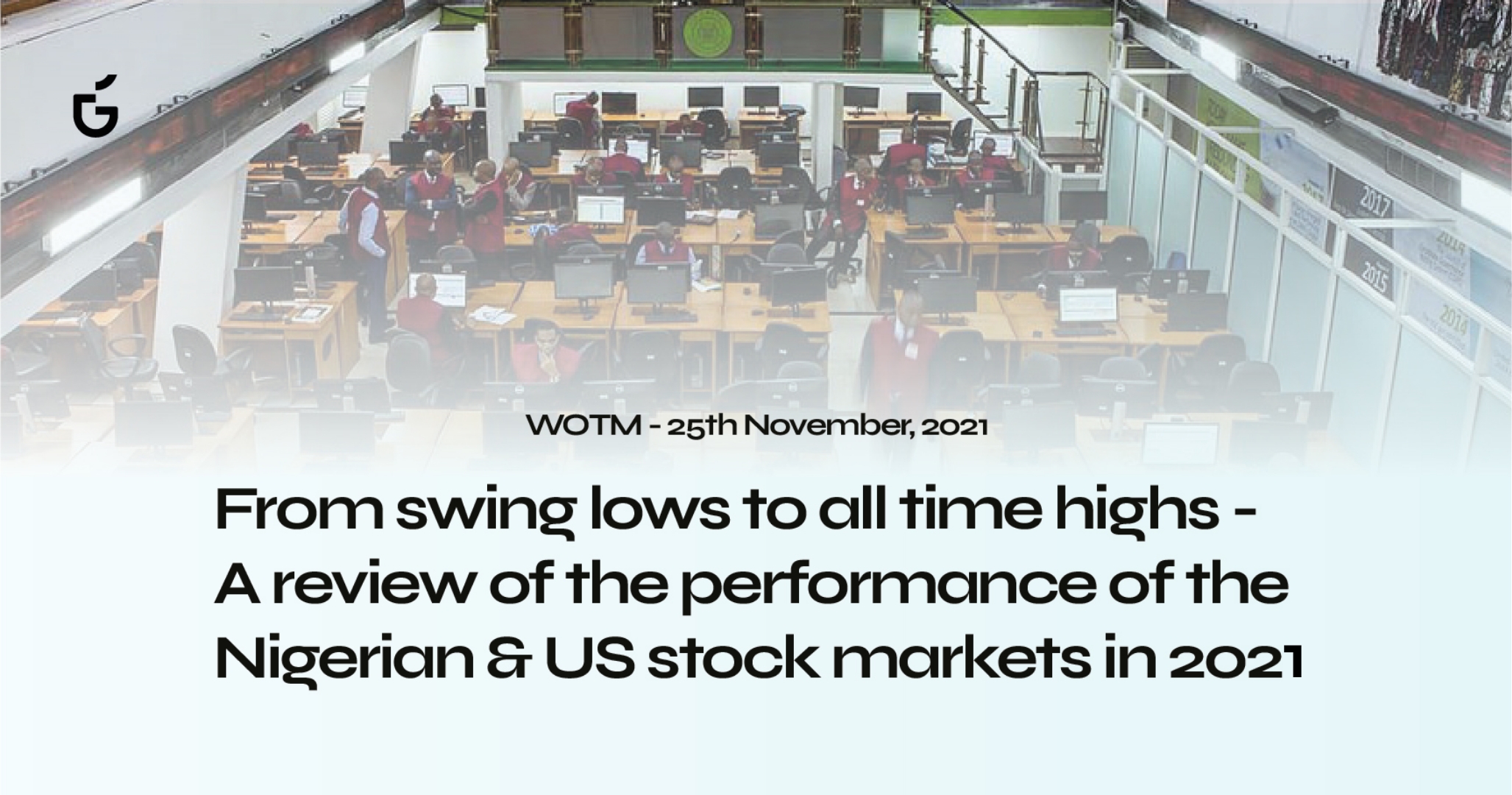 Africa
AfricaUnderstanding how companies are valued – A look into the MainOne acquisition
15 December, 2021
22 April, 2021 | 4 MINS READ
The Story
The governor of Edo State, Godwin Obaseki, made a statement accusing the Central Bank of Nigeria (CBN) of printing Naira to fund government spending. The Minister of Finance, Zainab Ibrahim, in reaction to this stated clearly that what is distributed by the Federal Accounts Allocation Committee commonly (FAAC) is revenue generated by government agencies like the Federal Inland Revenue Service (FIRS), Nigerian National Petroleum Corporation (NNPC) & the customs.
A couple of days later, The CBN governor Godwin Emefiele, in an attempt to provide an explanation stated there is nothing wrong with printing money to fund government spending as the economic effect of the pandemic warranted it.
What does it really mean to print money?
‘Printing money’ is a loose phrase used to describe how the central banking authority creates money to increase money supply in an economy. Typically, this is done during an economic downturn or economic recession. Economic recessions occur due to a sharp fall in business activities. When business activities decline, the CBN infuses money into the economy to grow business output and revive the economy,
Based on this, money is created in an economy in different ways.
Physical printing: This is when the CBN prints money off the printing press in notes, coins or cash as it is commonly called.
Digital money: The central bank creates money digitally by increasing the funds in the government’s account. For example: if the federal government had N200bn in its account with the CBN, the CBN can create more money by increasing the money in the federal government’s account to N700billion. In summary, the money in bank accounts is digital money, while money in purses is physical money.
Covid-19 has seen countries around the world increase money supply through digital money. In the US for example, citizen’s accounts were credited with stimulus packages as a means of curbing the economic impact of the pandemic on households.
Typically, central banking authorities increase money supply through the following means;
Quantitative Easing
Quantitative easing as a term for increasing money supply was popularized by the Federal Reserve of the United States of America (USA) and other central banks in 2008, when they embarked on an aggressive push of funds into their economies after the crash of financial markets. It is a monetary policy tool used by central banks to increase money supply by buying back bonds and other government securities. In reacting to the economic effect of Covid-19, the Federal Reserve announced a quantitative easing plan of over $700bn in March 2020. Quantitative easing is done mainly to provide liquidity in times of economic/financial crisis. It is a tool of last resort as it is mostly used when the central bank has fewer tools to influence economic growth. To better understand quantitative easing, this is how buying back of bonds and other government securities work:
Bond Buy Back
This is a situation in which the central bank buys back issued bonds from banks and other financial institutions in a bid to increase money supply, increasing money supply lowers the cost of money which in turn reduces interest rate. Lower interest rates make it cheaper to borrow money from banks to do business and grow the economy. The central bank in trying to control inflation (in a situation where is there is too much money in the economy) sells government securities like bonds and treasury bills to investors, investors pay cash for these securities and gets bonds & treasury bills from the central bank. By doing this, the government mops up money from the economy. A bond buy back is the opposite of this. The central bank buys back the bonds it issued and gives money back to banks and other financial institutions, thereby putting money back into the economy.
There is nothing wrong with increasing money supply or creating more money as long the monies created is used to expand production and output which will lift an economy out of a recession. What we should really pay attention to is how the money created is used.
Nigeria’s History with Increasing Money Supply
State governments in Nigeria in 2015/16 ran into troubled waters. They were affected by the recession that came with the fall in oil prices at the time. Most of these states have very little internally generated revenue and so when federal allocation to the states started to decline as a result of lower revenue from oil, they cried out for help. The federal government in a bid to help the economies of these states through the central bank, lent them money. Money was digitally created by directly creating the states accounts.
The thing about creating more money is that it’s supposed to spur economic activities, money pushed into the economy is supposed to be used for activities that increase economic output and improve economic growth. For example, if an economy has been badly hit by a recession (meaning economic output is very low) the government via the central bank would push money into different sectors of the economy to increase capital investment to those sectors thereby growing employment and economic output.
The Central Bank of Nigeria (CBN) in giving money to state governments in 2015/16 didn’t achieve its aim of spurring the economies of these states. The state governments didn’t push the funds into the industrial development of their states, neither did they invest in infrastructure rather the funds were committed to recurrent expenditure and subjected to the phony activities.
Though the Central Bank governor claims he’s helping the government deal with the revenue shortage that came with the pandemic, we believe directly crediting the government money will not contribute to the Nigerian economy. The funds will go into recurrent expenditure, waste and private pockets as has been the trend in Nigeria.
How Does Increasing Money Supply Affect Inflation?
The effect increased money supply has on inflation is dependent on how the funds created is used. In a situation where money supply is increased without a commensurate increase in output, we would have money chasing few goods i.e. demand will exceed supply. Prices of goods and services will be rise as the money created didn’t increase output, it just increased the volume of money in the economy.
The sole aim of increasing money supply in a recession is to improve economic output and bring the economy out of a recession. To put this in perspective, let’s put numbers to it. Assume an economy has $2,000,000 in supply (i.e. the total monies available in the economy is $2,000,000) and this economy produces 200,000 mobile phones. The money in circulation can purchase mobile phones at $10 a piece. If the government decides to add $1,000,000 to the money in circulation but does this by investing in the production of mobile phones, sending its citizens for trainings abroad to learn more about making mobile phones, created fully equipped technology hubs around the country, give no-interest loans to manufacturers of mobile phones. All of these will make output increase faster than money supply, output of mobile phones will grow to 500,000. With just $3,000,000 in circulation, the price of mobile phones will drop to $6.
This shows that increasing money supply, if done right, will grow output and cushion the negative effect recession has on inflation.
But the situation in Nigeria is different, with elections coming up in less than 2 years, the increase in money supply going directly to government coffers would be used to fund recurrent expenditure and political ambitions. The increase in money supply will put more pressure on foreign exchange as some of these funds would be converted to dollars in preparations for the elections in 2023. With scarce foreign exchange being a major cause of Nigeria’s high inflation, the increase in money supply will most likely drive inflation higher in the interim.
How the increase in Money Supply Affects your Portfolio
The rise in money supply is expected to put more pressure on foreign exchange and drive inflation higher. This may lead to further depreciation of the Naira and the real return on investment.
How Do I Invest to Protect My Portfolio from Inflation?
To protect your investment portfolio from inflation, you’ll have to invest a percentage of your portfolio in assets that have returns higher than inflation. Inflation in Nigeria as of March 2021 is 18.17%, assets with returns higher than this (stocks, agrotech, venture capital etc.) are high risk assets. Hence, proper research is necessary before you take position in any of these assets.
Financial education is at the core of what we do at the Green Investment Club, and we provide our members with detailed information on how to position their portfolios in different economic climes. Join our waitlist now to get alerted when we open to new members.
 Africa
Africa15 December, 2021
 Africa
Africa09 December, 2021
Join the biggest
investment club in Nigeria.